Related Research Articles
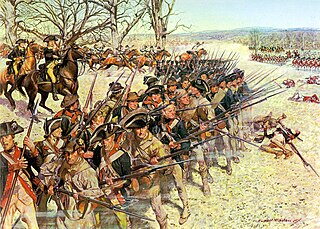
The Battle of Guilford Court House was on March 15, 1781, during the American Revolutionary War, at a site that is now in Greensboro, the seat of Guilford County, North Carolina. A 2,100-man British force under the command of Lieutenant General Charles Cornwallis defeated Major General Nathanael Greene's 4,500 Americans. The British Army, however, suffered considerable casualties.
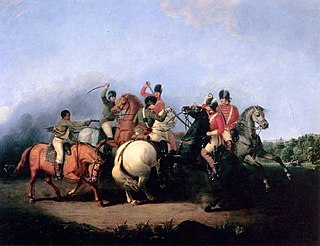
The Battle of Cowpens was an engagement during the American Revolutionary War fought on January 17, 1781 near the town of Cowpens, South Carolina, between American Patriot forces under Brigadier General Daniel Morgan and British forces, nearly half American Loyalists, under Lieutenant Colonel Banastre Tarleton, as part of the campaign in the Carolinas. The battle was a turning point in the American reconquest of South Carolina from the British.

Isaac Huger was a planter and Continental Army general during the American Revolutionary War.
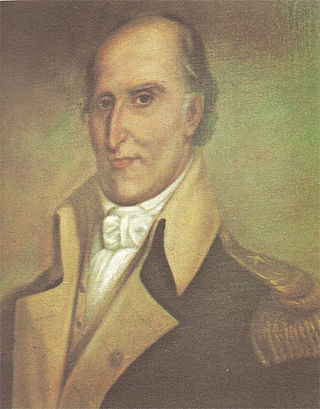
The Battle of Kettle Creek was the first major victory for Patriots in the back country of Georgia during the American Revolutionary War that took place on February 14, 1779. It was fought in Wilkes County about eleven miles (18 km) from present-day Washington, Georgia. A militia force of Patriots decisively defeated and scattered a Loyalist militia force that was on its way to British-controlled Augusta.

The southern theater of the American Revolutionary War was the central theater of military operations in the second half of the American Revolutionary War, 1778–1781. It encompassed engagements primarily in Virginia, Georgia, North Carolina, and South Carolina. Tactics consisted of both strategic battles and guerrilla warfare.
The Hillsborough District Brigade of militia was an administrative division of the North Carolina militia established on May 4, 1776. Brigadier General Thomas Person was the first commander. Companies from the eight regiments of the brigade were engaged in 55 known battles and skirmishes in North Carolina, South Carolina, and Georgia during the American Revolutionary War. It was active until the end of the war.
Jethro Exum Sumner was a senior officer of the Continental Army during the American Revolutionary War. Born in Virginia, Sumner's military service began in the French and Indian War as a member of the state's Provincial forces. After the conclusion of that conflict, he moved to Bute County, North Carolina, where he acquired a substantial area of land and operated a tavern. He served as Sheriff of Bute County, but with the coming of the American Revolution, he became a strident patriot, and was elected to North Carolina's Provincial Congress.
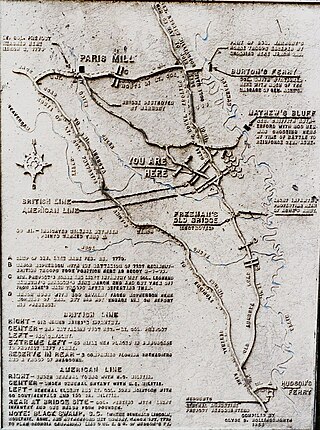
The Battle of Brier Creek was an American Revolutionary War battle fought on March 3, 1779, near the confluence of Brier Creek with the Savannah River in eastern Georgia. A mixed Patriot force consisting principally of militia from North Carolina and Georgia along with some Continental regulars was defeated, suffering significant casualties. The rout damaged Patriot morale.
James Moore was a Continental Army general during the American Revolutionary War. Moore was born into a prominent political family in the colonial Province of North Carolina, he was one of only five generals from North Carolina to serve in the Continental Army. He spent much of his childhood and youth on his family's estates in the lower Cape Fear River area, but soon became active in the colonial military structure in North Carolina.
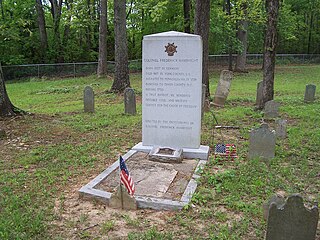
Frederick Hambright was a military officer who fought in both the local militia and in the North Carolina Line of the Continental Army during the Revolutionary War. He is best known for his participation in the Battle of Kings Mountain in 1780. Serving as a statesman early in the Revolution, Hambright joined the war in 1777, ranked a lieutenant colonel in a local militia. His early actions were limited to occasional checks on Loyalist groups. This changed in 1780 with Hambright's important role at the Battle of Kings Mountain, which occurred near his lands in the newly formed Lincoln County, North Carolina. Hambright was commended for his bravery during the battle, though suffering a wound which forced him to permanently resign from military service.
Pinketham "Pink" Eaton of North Carolina was a distinguished American officer in the Continental Army during the American Revolutionary War. He was the uncle of John H. Eaton, who served as a United States senator from Tennessee and Secretary of War.
John Butler was a military officer in the Hillsborough District Brigade of the North Carolina militia during the American Revolutionary War from 1775 to 1784, and served as its commanding general between 1779 and the end of the conflict. He was a member of the North Carolina House of Commons for several terms simultaneously with his military service. Butler commanded soldiers in several major engagements throughout North and South Carolina, but is perhaps best remembered for his role in the Patriot defeat at the Battle of Lindley's Mill. Butler died shortly after the end of the war, and his career as a military commander has received mixed reviews by historians.
Thomas Eaton was a military officer in the North Carolina militia during the War of the Regulation in 1771 and American Revolutionary War from 1775 to 1784. He was a member of the North Carolina Provincial Congress and North Carolina House of Commons for several terms simultaneously with his military service. Eaton was a member of the North Carolina Council of State under Governor Richard Caswell. Eaton commanded soldiers in the battles of Brier Creek and Guilford Courthouse. At the time of the 1790 census, Eaton was one of the largest slaveholders in North Carolina.
The Anson County Regiment was authorized on September 9, 1775 by the Third North Carolina Provincial Congress. The regiment was engaged in battles and skirmishes against the British and Cherokee during the American Revolution in North Carolina, South Carolina and Georgia between 1776 and 1781. It was active until the end of the war.
The Guilford County Regiment was authorized on September 9, 1775 by the Third North Carolina Provincial Congress. It was subordinate to the Salisbury District Brigade of militia. The regiment was engaged in battles and skirmishes against the British and Cherokee during the American Revolution in North Carolina, South Carolina and Georgia between 1776 and 1781. It was active until the end of the war.
The Edenton District Brigade was an administrative division of the North Carolina militia during the American Revolutionary War (1776–1783). This unit was established by the North Carolina Provincial Congress on May 4, 1776, and disbanded at the end of the war.
The New Bern District Brigade was an administrative division of the North Carolina militia during the American Revolutionary War (1776–1783). This unit was established by the North Carolina Provincial Congress on May 4, 1776, and disbanded at the end of the war.
North Carolina state troops in the American Revolution were the initial military units created in a transition from the Province of North Carolina under British rule to independence from British rule. Most units did not last long as such and were either transferred to the Continental Army or state militia instead.
The Warren County Regiment was established on January 3, 1779 by the North Carolina General Assembly when Bute County and its Regiment of militia were abolished. The regiment was engaged in battles and skirmished in North Carolina, South Carolina, and Georgia.
The Royal North Carolina Regiment was a provincial corps of Loyalists from the Province of North Carolina during the American Revolution. Provincial corps were regiments with both British and Loyalist forces.
References
Notes
- 1 2 3 4 5 6 7 8 Troxler & Menius 1988, p. 16.
- ↑ Lewis, J.D. "Loyalist Officers". The American Revolution in North Carolina. Retrieved April 22, 2019.
- ↑ Lewis, J.D. "Royal NC Regiment". The American Revolution in North Carolina. Retrieved April 22, 2019.
- ↑ Babits & Howard 2009, p. 209.
- ↑ Rankin 1971, p. 205.
- ↑ Buchanan 1997, p. 134–135.
- ↑ Buchanan 1997, p. 164.
- ↑ Troxler & Menius 1988, p. 16–17.
Bibliography
- Babits, Lawrence E.; Howard, Joshua B. (2009). Long, Obstinate, and Bloody: The Battle of Guilford Courthouse. Chapel Hill, NC: University of North Carolina Press. ISBN 9780807832660.
- Buchanan, John (1997). The Road to Guilford Courthouse: The American Revolution in the Carolinas. New York: John Wiley & Sons, Inc. ISBN 047116402X.
- Rankin, Hugh F. (1971). The North Carolina Continentals. Chapel Hill, NC: University of North Carolina Press. ISBN 9780807811542.
- Troxler, Carole W; Menius, Arthur C. (1988). "Hamilton, John". In Powell, William S (ed.). Dictionary of North Carolina Biography. Vol. 3 (H–K). Chapel Hill: University of North Carolina Press. ISBN 9780807818060.